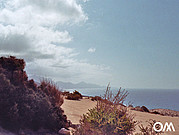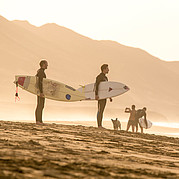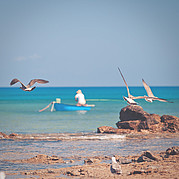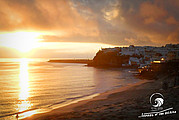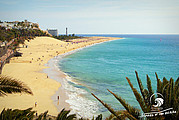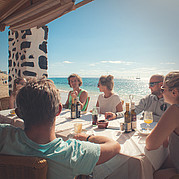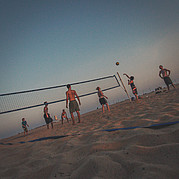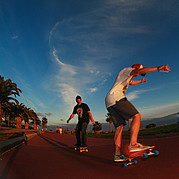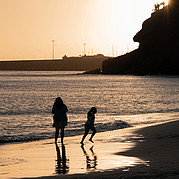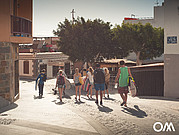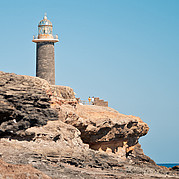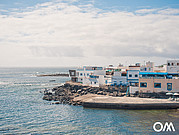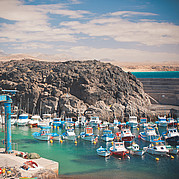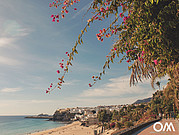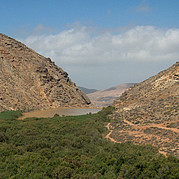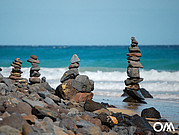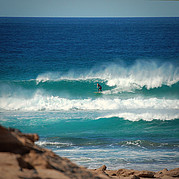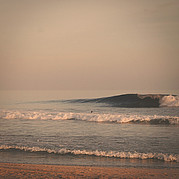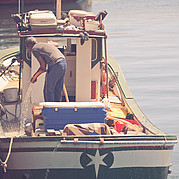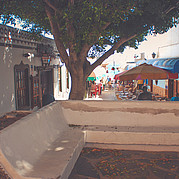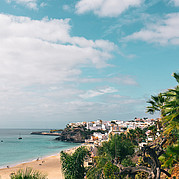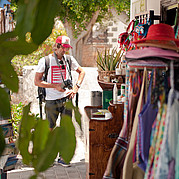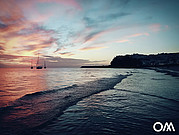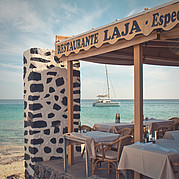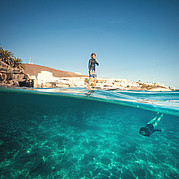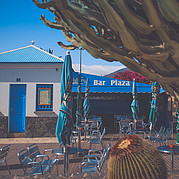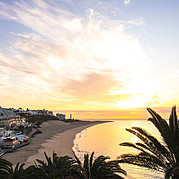Surfing at Cofete Beach in Fuerteventura
Cofete beach on Fuerteventura is the longest and also the most remote beach on the island. You can only get to Cofete by car via a 16-kilometre gravel road.
In rankings of the most beautiful and spectacular beaches in the world, Cofete in Fuerteventura is regularly among the top 10. And absolutely deserved! Even locals who have often seen the endless white beach, the azure blue water and the majestically rising mountains behind it, like to come to Cofete again and again. They are not the only ones impressed by the barren beauty of this pristine and very special landscape.
Cofete was the first settled place in the south of Fuerteventura and not, as many assume, Morro Jable, located on the other side of the mountains. The original inhabitants of Fuerteventura were farmers and cattle breeders. It rained more often on the high mountain massif behind Cofete than on the south coast facing away from the open Atlantic. Therefore, there was more drinking water for people, animals and plants in Cofete.
The deserted car park surrounded by a stone wall just before the beach is a silent witness to this early settlement. The original village of Cofete is now a settlement of simple stone-built houses and huts. There is also a bar where you can eat fresh tapas. You will also find a small exhibition room with pictures and old tools from the history of the village.
For most visitors, however, the most exciting sight in Cofete is the mysterious Villa Winter. It lies lonely above the village and under the highest mountains of Fuerteventura. The German engineer Gustav Winter had this house built in the 1940s after receiving the land as a gift from the Spanish government. To this day, there are many myths and mysteries surrounding the history of Villa Winter on Fuerteventura. These range from a hideout for Nazi leaders before fleeing to South America, to a secret submarine base in a grotto with hidden loot gold. For those who want to look more closely at the exciting history of the place and Villa Winter, I recommend a guided walking tour of Cofete.
For us surfers, the trip to Cofete is interesting for a different reason. On the endless beach there are countless sandbanks of different kinds and very rarely other surfers. With the right conditions, everyone can find their personal sandbank here with clean waves, from crystal clear water.
Directions to Cofete in Fuerteventura
You drive on the motorway in the south of FuerteventuratowardsMorro Jable. At the end of the motorway, after passing under a bridge and driving down a hill, the long, two-lane beach promenade of Jandia begins. Just follow the road in the direction of Morro Jable.
At the end of the promenade, the road winds up the hill that separates Morro Jable from Jandia. Follow the road, which now runs above Morro Jable, in the direction of the harbour (Muelle in Spanish). You will pass a large roundabout. From here you will reach the upper part of the village. The road then heads back towards the sea and slightly downhill towards the port.
In a bend, from where you can already see parts of the harbour, there is a small turn-off to the right. Here there should be a sign showing the way to the cemetery (span. Cementerio) of Morro Jable. There are also some rubbish containers at the edge of this bend. Follow the road at this junction towards the cemetery. After a few bends above the port of Morro Jable, you will pass the cemetery and the asphalt road will turn into an unpaved gravel road.
Caution:
Many car rental companies are not liable for damage to their vehicles if it occurs off paved roads. The gravel road to Cofete is resurfaced at least twice a year, but there are still very rough passages with large holes. If you drive this track with a "normal" car, you should do so carefully. From the cemetery, the gravel road winds in many curves for several kilometres further south. After you have passed a mountain flank at about halfway, a wide view of the westernmost part of the island opens up, at the end of which lies the village of Punta de Jandia and the westernmost lighthouse of Fuerteventura. This is also where the gravel road ends.
Long before that, still in the part of the track further up the mountain flank, comes the well-signposted descent to Cofete beach. This descent leads in narrow serpentines up the mountain to the pass between the south coast and the north-facing beach of Cofete. At the top of the pass you have a fantastic view of both coasts. There is a small parking area and a coin-operated telescope. It is not uncommon to see goats or wild donkeys foraging for the sparse green stalks. These grow thanks to the humid air up here.
After the pass, the gravel road leads down a steep mountain flank to the beach of Cofete. This part of the road is not for the faint-hearted, as it is relatively narrow and slopes very steeply on the side facing the sea. Before bends, you should honk briefly to attract the attention of oncoming vehicles. As you continue, the road widens and runs parallel to the beach until you reach the large car park in Cofete. During the drive, you can already see numerous waves breaking on the countless sandbanks.
The waves at Cofete beach in Fuerteventura
There is still a persistent opinion among many locals and also among surfers from the south that the waves in Cofete are much bigger than comparable waves on the west coast, for example in La Pared. My experience does not confirm this. The waves in Cofete basically follow the same physics as other waves on long open beaches. Personally, I find that the waves in Cofete often have similarities to the waves at French beach breaks.
As on all beaches, the sandbanks in Cofete are constantly in motion. After every heavy storm with big powerful waves, the position and shape of the sandbanks change and so does the shape of the waves. It is worth looking for good waves from the gravel road. Because new sandbanks are constantly forming on the beach, so you can always discover new good waves.
In recent years, I have surfed a lot in Cofete. My experience is that there are often good waves right in front of the large car park. A second spot with good waves is a little further south of the car park, at the level of the small goat stables. In recent years, there have often been very good sandbanks here as well.
In which conditions do you surf in Cofete on Fuerteventura?
Also in Cofete, the shape of the waves and the way they break can change greatly with the tide. Advanced surfers go to Cofete at medium tide levels. My experience is that the waves in Cofete are best between low and high tide, up to high tide.
At low tide, the waves often break very quickly and sometimes as a whole, i.e. "close out" onto the sandbanks.
The wide foam waves are also good for surfing in white water at low tide. However, there are no lifeguards in Cofete and only rarely other surfers who could warn surfing beginners about waves or currents that are too strong. I therefore recommend all beginners to make their first surfing attempts in La Pared. Of course, this is also best done under professional guidance in one of our surf courses for beginners.
On days with very small waves, you can surf good, unbroken (green) waves in Cofete even at low tide. On days with comparatively big waves, you are more likely to surf at high tide. The waves that break on the west coast of Fuerteventura are usually created many thousands of kilometres away on the open Atlantic. Therefore, the wave height on the west coast of a 98km long island does not differ significantly. So waves in Cofete are certainly not bigger than in La Pared, for example. But this also means that if the waves in La Pared are too big for surfing, they are also too big in Cofete.
It's a different story with the wind. Thanks to the high mountains behind the beach, it is often less windy in Cofete than in La Pared. The real trump card of Cofete, however, is the seemingly endless number of sandbanks. If the sandbanks in La Pared are not good or there are too many surfers in the water, you will always find an empty sandbank with good waves in Cofete. If the waves in Cofete are too big, there are often small and clean waves to surf at Jandia beach.
What do you have to watch out for when surfing in Cofete on Fuerteventura?
As already mentioned, the waves in Cofete are not bigger than other waves at beaches on the west coast. Nevertheless, Cofete is absolutely not a beach for surfing beginners, because in Cofete you usually surf alone. I rarely saw other surfers in Cofete and of course there are no lifeguards. At Cofete beach you surf by yourself and therefore you need to be realistic about your own surfing level. Every surfer should be sensible enough not to enter the water if conditions cannot be assessed. Since there are almost never other surfers around to warn you of currents or other dangers, there is also no one around to call an ambulance in an emergency. Even if an ambulance is called, you can probably imagine how much time it takes to get to Cofete.
What is risky for novice surfers is pure luxury for advanced surfers. They are looking for that one wave that they only have to or are allowed to share with their friends. Apart from the remoteness of the beach, there are no hidden dangers in Cofete. There are no stones in the water or anything like that. There is usually a current that runs parallel to the beach. Its direction (north or south) can change on a daily basis, depending on the angle at which the waves hit the beach. There are also currents between all the sandbanks that go out to sea and behind the breaking waves.
Just like on French beaches, the shorebreak (waves crashing directly onto the beach at high tide) can be very powerful in Cofete. The same applies to the waves themselves. Even from the beach, you often underestimate the power of the waves in Cofete and only realise their size when you paddle out on your surfboard.


